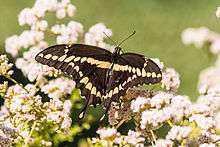Papilio cresphontes
| Giant swallowtail | |
|---|---|
| | |
| Scientific classification | |
| Kingdom: | Animalia |
| Phylum: | Arthropoda |
| Class: | Insecta |
| Order: | Lepidoptera |
| Family: | Papilionidae |
| Genus: | Papilio |
| Species: | P. cresphontes |
| Binomial name | |
| Papilio cresphontes Cramer, [1777] | |
| Synonyms | |
|
Heraclides oxilus Hübner, [1819] | |
Papilio cresphontes, the giant swallowtail or in its larval phase the orange dog or orange puppy, is a swallowtail butterfly common in parts of North America and marginally into South America (Colombia and Venezuela only). In the United States and Canada it is mainly found in the south and east. With a wingspan of about 10–16 cm (3.9–6.3 in),[2] it is the largest butterfly in Canada and the United States.[3]
Description

Adult
An adult's wingspan is about 100–160 mm (3.9–6.3 in).[2] The body and wings are dark brown to black with yellow bands. There is a yellow eyespot in each wing's tail. The abdomen has bands of yellow along with the previously mentioned brown. Adults are quite similar to the adults of another Papilio species, P. thoas.
Caterpillar
The mature caterpillar resembles bird droppings to deter predators, and if that doesn't work they use their orange osmeteria. These are "horns" which they can display and then retract. The coloration is dingy brown and or olive with white patches and small patches of purple. Citrus fruit farmers often call the caterpillars orange dogs or orange puppies because of the devastation they can cause to their crops.
Range and habitat

In the United States, P. cresphontes is mostly seen in deciduous forest and citrus orchards where they are considered a major pest. They fly between May and August where there are two broods in the north and three in the south. They can range from southern California (where they have been seen from March to December, reaching peak abundance in late summer/early fall), Arizona as deep south as Mexico north into southeastern Canada. Outside the United States and Canada they are found in Mexico, Central America, Colombia, Jamaica and Cuba.
Life cycle
Adult females lay their eggs singly on the surface of the host plant, this egg is bright orange and darkens with time. The caterpillars then eat and grow to about 2 in (5.1 cm) before changing into a chrysalis. The chrysalis stage is variable but usually takes approximately 10–12 days, although in the fall they may stay in the chrysalis stage over winter and emerge in the spring.
 Egg
Egg P. cresphontes caterpillar on lemon leaf
P. cresphontes caterpillar on lemon leaf- P. cresphontes caterpillar showing defensive posture
- Adult, underside
Flight
Giant swallowtails fly from Late May–August, but in some areas of the southern United States such as Texas and Louisiana, they may be seen as late as October. All giant swallowtails have a distinctive flight pattern which generally looks as if they are "hopping" through the air. Females tend to beat their wings slowly but move quickly. Because females have such large wings, each wing beat will carry it a long way. Males however, tend to have more of a darty flight and beat their wings rapidly but move slower than females because their wings are smaller and each beat doesn't carry them far. Giant swallowtails in general fly fast and high and can be difficult to capture.
References
- ↑ "Papilio cresphontes - Cramer, 1777 Giant Swallowtail". NatureServe Explorer. NatureServe. 2009-08-19. Retrieved 2010-08-24.
- 1 2 3 4 "Giant Swallowtail Papilio cresphontes Cramer, 1777". Butterflies and Moths of North America. 2006. Retrieved 2010-08-24.
- ↑ Darby, Gene (1958). What is a Butterfly. Chicago: Benefic Press. p. 35.
- ↑ "Giant swallowtail Papilio cresphontes Cramer". Featured Creatures. University of Florida Institute for Food and Agricultural Sciences. September 2009. Retrieved 2010-08-24.
- Burris, Judy; Richards, Wayne (2006). The Life Cycle of Butterflies. Storey Publishing. pp. 24–25. ISBN 978-1-58017-617-0.
- Kaufman, Kenn; Eaton, Eric R. (2007). "Swallowtails and Pierids". Kaufman Field Guide to Insects of North America. Houghton Mifflin Books. pp. 230–231. ISBN 978-0-618-15310-7.
- Milne, Margery & Lorus (2005) [1980]. "Butterflies and moths". National Audubon Society Field Guide to North American Insects & Spider (23rd ed.). Alfred A. Knopf, Inc. pp. 719–720. ISBN 0-394-50763-0.
- Evans, Arthur V. (2007). "Butterflies and Moths: Order Lepidoptera". Field Guide to Insects and Spider of North America. Sterling Publishing Co., Inc. p. 261. ISBN 978-1-4027-4153-1.
- Kaufman, Kenn; Brock, Jim P. (2003). "Swallowtails and Parnassians". Kaufman Field Guide to Butterflies of North America. Houghton Mifflin Books. pp. 38–39. ISBN 978-0-618-76826-4.
- "Species Detail Butterflies and Moths of North America". Retrieved 2009-01-18.
- "Species Papilio cresphontes - Giant Swallowtail - BugGuide.Net". Retrieved 2009-01-18.
External links
| Wikimedia Commons has media related to Papilio cresphontes. |
| Wikispecies has information related to: Papilio cresphontes |
- Giant swallowtail butterfly life cycle photographs
- Giant Swallowtail on the UF / IFAS Featured Creatures Web site
- Butterflycorner Images from Naturhistorisches Museum Wien
- Giant Swallowtail, Butterflies and Moths of North America
- Papilio cresphontes, funet.fi
- Giant swallowtail caterpillar - High definition video
